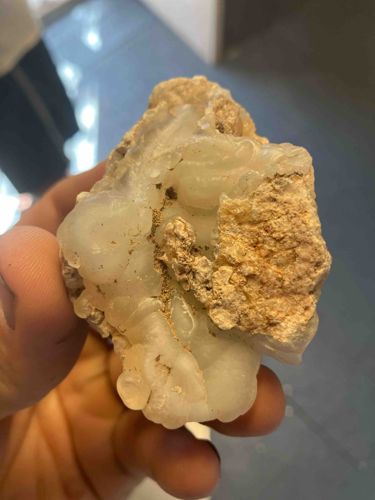
Botryoidal Chalcedony with Matrix
This item is an unpolished, raw specimen primarily composed of translucent to opaque botryoidal chalcedony with attached matrix material. The chalcedony exhibits a milky white to light yellowish-cream color, with a waxy to resinous luster on its botryoidal surfaces. The botryoidal formation, characterized by numerous rounded, grape-like structures, is clearly visible, varying in size from small nodules to larger, more confluent masses. Portions of the specimen consist of a rough, earthy matrix, likely a host rock, which is a light brown to tan color and feels gritty to the touch. This matrix appears to be firmly attached to the chalcedony, suggesting it is a natural part of the formation and not an artificial attachment. Small specks of darker material, possibly dirt or other mineral inclusions, are visible within crevices and on the rougher surfaces of both the chalcedony and the matrix. The overall size of the specimen appears to be hand-held, fitting comfortably within a person's palm, as indicated by the fingers visible in the image. There are no apparent major fractures or repairs, and its condition is consistent with a naturally occurring mineral fragment. Given its natural, unworked state and mineralogical characteristics, it is likely a relatively old formation, possibly Mesozoic to Cenozoic in origin, common for such mineral deposits. There are no discernible manufacturer's marks or signatures, which is typical for raw mineral specimens. The quality is indicative of a natural geological formation, valued more for its scientific and aesthetic characteristics as a mineral specimen rather than for craftsmanship.
AI-Generated Appraisal Disclaimer
Estimated Value
$75-125
Basic Information
Category
Mineral Specimen
Appraised On
December 7, 2025
Estimated Value
$75-125
Item Description
This item is an unpolished, raw specimen primarily composed of translucent to opaque botryoidal chalcedony with attached matrix material. The chalcedony exhibits a milky white to light yellowish-cream color, with a waxy to resinous luster on its botryoidal surfaces. The botryoidal formation, characterized by numerous rounded, grape-like structures, is clearly visible, varying in size from small nodules to larger, more confluent masses. Portions of the specimen consist of a rough, earthy matrix, likely a host rock, which is a light brown to tan color and feels gritty to the touch. This matrix appears to be firmly attached to the chalcedony, suggesting it is a natural part of the formation and not an artificial attachment. Small specks of darker material, possibly dirt or other mineral inclusions, are visible within crevices and on the rougher surfaces of both the chalcedony and the matrix. The overall size of the specimen appears to be hand-held, fitting comfortably within a person's palm, as indicated by the fingers visible in the image. There are no apparent major fractures or repairs, and its condition is consistent with a naturally occurring mineral fragment. Given its natural, unworked state and mineralogical characteristics, it is likely a relatively old formation, possibly Mesozoic to Cenozoic in origin, common for such mineral deposits. There are no discernible manufacturer's marks or signatures, which is typical for raw mineral specimens. The quality is indicative of a natural geological formation, valued more for its scientific and aesthetic characteristics as a mineral specimen rather than for craftsmanship.
Related Tags
Get Your Items Appraised
Instant estimates of your treasures with AI-powered instant appraisals